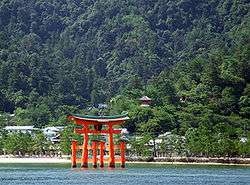List of national parks of Japan

National Parks (国立公園 Kokuritsu Kōen) and Quasi-National Parks (国定公園 Kokutei Kōen) in Japan are places of scenic beauty designated for protection and sustainable usage by the Minister of the Environment under the Natural Parks Law (1957).[1] National Parks are designated and in principle managed by the Ministry of the Environment. Quasi-National Parks, of a slightly lesser beauty, size, diversity, or state of preservation, are recommended for ministerial designation and managed by the Prefectures under the supervision of the Ministry.[2]
History
Japan established its first kōen (公園) or public parks in 1873 (Asakusa Park, Asukayama Park, Fukagawa Park, Shiba Park, and Ueno Park). In 1911 local citizens petitioned that the shrines and forests of Nikkō be placed under public protection and in 1929 the National Parks Association was formed. In 1931 the first National Parks Law was passed and, after much study and survey, in March 1934 the first parks were established - Setonaikai, Unzen and Kirishima - with five more in December and a further three two years later. Ise-Shima was the first to be created after the war, and a further seven had been added by 1955. In 1957 the Natural Parks Law replaced the earlier National Parks Law, allowing for three categories of park, the National, Quasi-National, and Prefectural Natural Parks. With minor amendments this established the framework that operates today.[3][4]
As of 1 April 2014, there were 31 National Parks and 56 Quasi-National Parks, with the National Parks covering 20,996 km² (5.6% of the land area) and the Quasi-National Parks 13,592 km² (3.6% of the land area). In addition, there were 314 Prefectural Parks covering 19,726 km² (5.2% of the land area).[5] On 27 March 2015, the 32nd National Park was established, Myōkō-Togakushi Renzan National Park.[6]
Protection status
The area of each National and Quasi-National Park is divided into ordinary, special and marine park zones. Special zones are further subdivided into special protection and class I, II, and III special zones, restricting access and use for preservation purposes. The state owns only approximately half of the land in the parks.[7]
See also
- Special Places of Scenic Beauty
- Places of Scenic Beauty
- National Government Parks
- Wildlife Protection Areas in Japan
- List of Ramsar sites in Japan
References
- ↑ "Natural Parks Act (1957)" (PDF). Ministry of the Environment. Retrieved 1 February 2012.
- ↑ "Natural Park Systems in Japan" (PDF). Ministry of the Environment. pp. 4, 12. Retrieved 1 February 2012.
- ↑ Sutherland, Mary; Britton, Dorothy (1995). National Parks of Japan. Kodansha. pp. 6f. ISBN 4-7700-1971-8.
- ↑ "Natural Park Systems in Japan" (PDF). Ministry of the Environment. pp. 1f. Retrieved 1 February 2012.
- ↑ "Summary table of area figures for Natural Parks" (PDF). Ministry of the Environment. 1 April 2014. Retrieved 29 November 2015.
- ↑ "Birth of Myoko Togakushi Renzan National Park". Ministry of the Environment. 10 June 2015. Retrieved 29 November 2015.
- ↑ "Natural Park Systems in Japan" (PDF). Ministry of the Environment. pp. 2f. Retrieved 1 February 2012.
External links
|